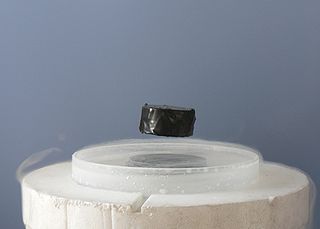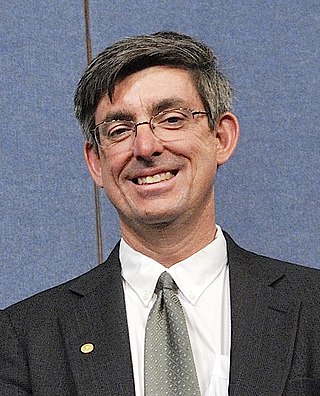
Condensed matter physics is the field of physics that deals with the macroscopic and microscopic physical properties of matter, especially the solid and liquid phases which arise from electromagnetic forces between atoms. More generally, the subject deals with condensed phases of matter: systems of many constituents with strong interactions among them. More exotic condensed phases include the superconducting phase exhibited by certain materials at extremely low cryogenic temperature, the ferromagnetic and antiferromagnetic phases of spins on crystal lattices of atoms, and the Bose–Einstein condensate found in ultracold atomic systems. Condensed matter physicists seek to understand the behavior of these phases by experiments to measure various material properties, and by applying the physical laws of quantum mechanics, electromagnetism, statistical mechanics, and other physics theories to develop mathematical models.

Superconductivity is a set of physical properties observed in certain materials where electrical resistance vanishes and magnetic fields are expelled from the material. Any material exhibiting these properties is a superconductor. Unlike an ordinary metallic conductor, whose resistance decreases gradually as its temperature is lowered, even down to near absolute zero, a superconductor has a characteristic critical temperature below which the resistance drops abruptly to zero. An electric current through a loop of superconducting wire can persist indefinitely with no power source.
In condensed matter physics, a Cooper pair or BCS pair is a pair of electrons bound together at low temperatures in a certain manner first described in 1956 by American physicist Leon Cooper.

Philip Warren Anderson was an American theoretical physicist and Nobel laureate. Anderson made contributions to the theories of localization, antiferromagnetism, symmetry breaking, and high-temperature superconductivity, and to the philosophy of science through his writings on emergent phenomena. Anderson is also responsible for naming the field of physics that is now known as condensed matter physics.

Sir Anthony James Leggett is a British-American theoretical physicist and professor emeritus at the University of Illinois at Urbana-Champaign. Leggett is widely recognised as a world leader in the theory of low-temperature physics, and his pioneering work on superfluidity was recognised by the 2003 Nobel Prize in Physics. He has shaped the theoretical understanding of normal and superfluid helium liquids and strongly coupled superfluids. He set directions for research in the quantum physics of macroscopic dissipative systems and use of condensed systems to test the foundations of quantum mechanics.

Jan Zaanen is professor of theoretical physics at Leiden University, the Netherlands. He is best known for his contributions to the understanding of the quantum physics of the electrons in strongly correlated material, and in particular high temperature superconductivity. Zaanen's areas of interest are in the search for novel forms of collective quantum phenomena realized in systems build from mundane constituents like electrons, spins, and atoms.
The Nevill Mott Medal and Prize is an award presented in selected years by the Institute of Physics in the United Kingdom, for distinguished research in condensed matter or materials physics. It was first established in 1997 thanks to a donation from Sir Nevill Mott's family. Sir Nevill Mott was one of the outstanding British condensed matter theorists and won a Nobel Prize in Physics in 1977. He died in 1996. The award consists of a silver medal and a prize of £1000.

Piers Coleman is a British-born theoretical physicist, working in the field of theoretical condensed matter physics. Coleman is professor of physics at Rutgers University in New Jersey and at Royal Holloway, University of London.

Distrontium ruthenate, also known as strontium ruthenate, is an oxide of strontium and ruthenium with the chemical formula Sr2RuO4. It was the first reported perovskite superconductor that did not contain copper. Strontium ruthenate is structurally very similar to the high-temperature cuprate superconductors, and in particular, is almost identical to the lanthanum doped superconductor (La, Sr)2CuO4. However, the transition temperature for the superconducting phase transition is 0.93 K (about 1.5 K for the best sample), which is much lower than the corresponding value for cuprates.
Ian Keith Affleck is a Canadian physicist specializing in condensed matter physics. He is Killam University Professor, Department of Physics and Astronomy, University of British Columbia.
William Frank Vinen was a British physicist specialising in low temperature physics.
Peter Fulde is a physicist working in condensed matter theory and quantum chemistry.
Gabriel Aeppli, PhD FRS is a Swiss-American electrical engineer, co-founder of the London Centre for Nanotechnology and professor of physics at ETH Zürich and EPF Lausanne, and head of the Synchrotron and Nanotechnology department of the Paul Scherrer Institute, also in Switzerland.
Gilbert "Gil" George Lonzarich is a solid-state physicist who works at the Cavendish Laboratory at the University of Cambridge. He is particularly noted for his work on superconducting and magnetic materials.
Eduardo Hector Fradkin is an Argentinian theoretical physicist known for working in various areas of condensed matter physics, primarily using quantum field theoretical approaches. He is a Donald Biggar Willett Professor of Physics at the University of Illinois at Urbana–Champaign, where he is the director of the Institute for Condensed Matter Theory, and is the author of the books Quantum Field Theory: An Integrated Approach and Field Theories of Condensed Matter Physics.
Mohit Randeria is a US-based Indian condensed matter physicist and a professor of physics at Ohio State University. Known for his research on condensed matter theory and superconductivity, Randeria is an elected fellow of the American Physics Society. The Council of Scientific and Industrial Research, the apex agency of the Government of India for scientific research, awarded him the Shanti Swarup Bhatnagar Prize for Science and Technology, one of the highest Indian science awards, for his contributions to physical sciences in 2002. He was awarded the 2002 ICTP Prize of the International Center for Theoretical Physics, Trieste and the 2022 John Bardeen Prize.
Amalia Ioana Coldea is a Romanian quantum physicist who is an Associate Professor at the University of Oxford. She was awarded the 2019 Institute of Physics Brian Pippard Prize and the 2011 EuroMagnet Prize.

John Louis Sarrao is an American physicist. He is the deputy director for science, technology, and engineering at Los Alamos National Laboratory. As of 2 October 2023, he will become the sixth director of SLAC National Accelerator Laboratory

Simon John Bending, is a British physicist. He is a professor in the Department of Physics at the University of Bath, where he was the Head of department from 2013 to 2016. He is co-director of the Bath-Exeter Centre for Graphene Science and deputy director of the Bath-Bristol EPRSC Centre for Doctoral Training in Condensed Matter Physics. He developed scanning Hall probe microscopy and has made notable contributions to the field of superconductors.
Dale J. Van Harlingen is an American condensed matter physicist.









